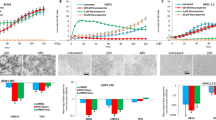Abstract
The elevated expression of prostate apoptosis response-4 (PAR-4) induces apoptosis in differentiating mouse embryonic stem (ES) cells. In embryoid body (EB) cells and the E15.5 stage of embryonic mouse brain, PAR-4 is expressed as two isoforms (38 and 33 kDa). Using mouse EB-derived RNA as a template we have cloned and characterized a novel isoform of PAR-4 (PAR-4/p33) that lacks exon 3 and shows a bona fide splice junction of exons 2 and 4. The molecular mass for PAR-4/p33 is estimated to be 33 kDa, corresponding to the short form found in the EB cells and E15.5 mouse brain. The fluorescent fusion protein of PAR-4/p33 is mainly found in the cytosol and is co-distributed with F-actin filaments, while that of the 38 kDa full length PAR-4/p38 is predominantly translocated to the nucleus. In contrast to the full length PAR-4 (PAR-4/p38), ectopic expression of PAR-4/p33 does not result in the activation of caspase 3 and the induction of apoptosis. PAR-4/p33 forms a complex with PAR-4/p38, which inhibits its nuclear translocation and the induction of apoptosis. PAR-4/p33 is suggested to be a dominant negative isoform of PAR-4/p38 and may regulate PAR-4-dependent apoptosis.
Similar content being viewed by others
References
Mattson MP. Excitotoxic and excitoprotective mechanisms: Abundant targets for the prevention and treatment of neurodegenerative disorders. Neuromolecular Med 2003; 3: 65–94.
Blaschke AJ, Staley K, Chun J. Widespread programmed cell death in proliferative and postmitotic regions of the fetal cerebral cortex. Development 1996; 122: 1165–1174.
Pettmann B, Henderson CE. Neuronal cell death. Neuron 1998; 20: 633–647.
Sommer L, Rao M. Neural stem cells and regulation of cell number. Prog Neurobiol 2002; 66: 1–18.
Bieberich E, MacKinnon S, Silva J, Yu RK. Regulation of apoptosis during neuronal differentiation by ceramide and b-series complex gangliosides. J Biol Chem 2001; 276: 44396–44404.
Bieberich E, MacKinnon S, Silva J, Noggle S, Condie BG. Regulation of cell death in mitotic neural progenitor cells by asymmetric distribution of prostate apoptosis response 4 (par-4) and simultaneous elevation of endogenous ceramide. J Cell Biol 2003; 162: 469–479.
Sells SF, Wood DP, Jr., Joshi-Barve SS, et al. Commonality of the gene programs induced by effectors of apoptosis in androgen-dependent and independent prostate cells. Cell Growth Differ 1994; 5: 457–466.
El-Guendy N, Zhao Y, Gurumurthy S, Burikhanov R, Rangnekar VM. Identification of a unique core domain of par-4 sufficient for selective apoptosis induction in cancer cells. Mol Cell Biol 2003; 23: 5516–5525.
Vetterkind S, Illenberger S, Kubicek J, et al. Binding of par-4 to the actin cytoskeleton is essential for par-4/dlk-mediated apoptosis. Exp Cell Res 2005; 305: 392–408.
Gurumurthy S, Rangnekar VM. Par-4 inducible apoptosis in prostate cancer cells. J Cell Biochem 2004; 91: 504–512.
Wang G, Silva J, Krishnamurthy K, et al. Direct binding to ceramide activates pkczeta prior to the formation of a pro-apoptotic complex with par-4 in differentiating stem cells. J Biol Chem 2005; 280: 26415–26424.
Minn AJ, Boise LH, Thompson CB. Bcl-x(s) anatagonizes the protective effects of bcl-x(l). J Biol Chem 1996; 271: 6306–6312.
Jiang ZH, Zhang WJ, Rao Y, Wu JY. Regulation of ich-1 pre-mrna alternative splicing and apoptosis by mammalian splicing factors. Proc Natl Acad Sci USA 1998; 95: 9155–9160.
Srinivasula SM, Ahmad M, Guo Y, et al. Identification of an endogenous dominant-negative short isoform of caspase-9 that can regulate apoptosis. Cancer Res 1999; 59: 999–1002.
Seol DW, Billiar TR. A caspase-9 variant missing the catalytic site is an endogenous inhibitor of apoptosis. J Biol Chem 1999; 274: 2072–2076.
Author information
Authors and Affiliations
Corresponding author
Rights and permissions
About this article
Cite this article
Wang, G., Silva, J., Krishnamurthy, K. et al. A novel isoform of prostate apoptosis response 4 (PAR-4) that co-distributes with F-actin and prevents apoptosis in neural stem cells. Apoptosis 11, 315–325 (2006). https://doi.org/10.1007/s10495-006-3979-8
Published:
Issue Date:
DOI: https://doi.org/10.1007/s10495-006-3979-8




